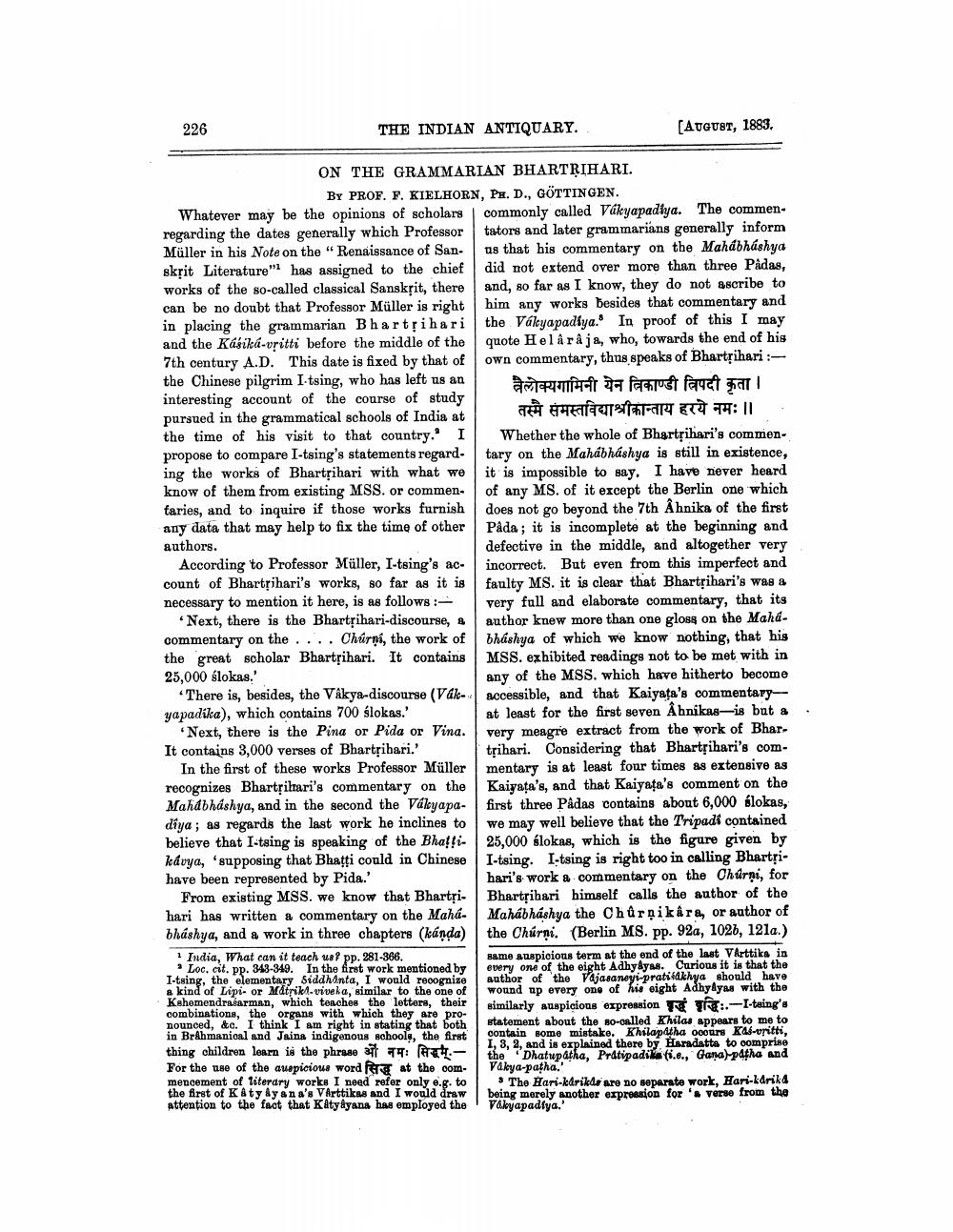________________
226
THE INDIAN ANTIQUARY.
[AUGUST, 1883
ON THE GRAMMARIAN BHARTRIHARI.
BY PROF. F. KIELHORN, PH.D., GÖTTINGEN. Whatever may be the opinions of scholars commonly called Vákyapadiya. The commenregarding the dates generally which Professortators and later grammarians generally inform Müller in his Note on the "Renaissance of San. us that his commentary on the Mahabháshya skřit Literature" has assigned to the chief did not extend over more than three Padas, works of the so-called classical Sanskpit, there and, so far as I know, they do not ascribe to can be no doubt that Professor Müller is right him any works besides that commentary and in placing the grammarian Bhartrihari the Vályapadiya. In proof of this I may and the Käsiká-vșitti before the middle of the quote Helår å ja, who, towards the end of his 7th century A.D. This date is fixed by that of own commentary, thus speaks of Bhartihari :the Chinese pilgrim I-tsing, who has left us an
त्रैलोक्यगामिनी येन त्रिकाण्डी विपदी कृता । interesting account of the course of study pursued in the grammatical schools of India at
तस्मै समस्तविद्याश्रीकान्ताय हरये नमः॥ . the time of his visit to that country. I Whether the whole of Bhartřihari's commenpropose to compare I-tsing's statements regard. tary on the Mahabháshya is still in existence, ing the works of Bhartsihari with what we it is impossible to say. I have never heard know of them from existing MSS. or commen. of any MS. of it except the Berlin one which taries, and to inquire if those works furnish does not go beyond the 7th Âhnika of the first any data that may help to fix the time of other Pada; it is incomplete at the beginning and authors.
defective in the middle, and altogether very According to Professor Müller, I-tsing's ac- incorrect. But even from this imperfect and count of Bhartřihari's works, so far as it is faulty MS. it is clear that Bhartřihari's was a necessary to mention it here, is as follows :- very full and elaborate commentary, that its
Next, there is the Bhartsihari-discourse, & author knew more than one glose on the Mahdcommentary on the ... Chúrni, the work of bháshya of which we know nothing, that his the great scholar Bhartsihari. It contains MSS. exhibited readings not to be met with in 25,000 slokas.'
any of the MSS. which have hitherto become * There is, besides, the Vákya-discourse (Vák- accessible, and that Kaiyata's commentaryyapadika), which contains 700 ślokas.'
at least for the first seven Åhnikas-is but a Next, there is the Pina or Pida or Vina. very meagre extract from the work of BharIt contains 3,000 verses of Bhartibari.
trihari. Considering that Bhartsihari's comIn the first of these works Professor Müller mentary is at least four times as extensive as recognizes Bhartsihari's commentary on the Kaiyata's, and that Kaiyata's comment on the Mahabhashya, and in the second the Vakyapa- first three Padas contains about 6,000 slokas, diya; as regards the last work he inclines to we may well believe that the Tripadi contained believe that I-tsing is speaking of the Bhalfi- 25,000 blokas, which is the figure given by kávya, 'supposing that Bhatti could in Chinese I-tsing. I-tsing is right too in calling Bhartrihave been represented by Pida.'
hari's work a commentary on the Charmi, for From existing MSS. we know that Bharti- Bhartibari himself calls the author of the hari has written a commentary on the Mahá. Mahábháshya the Chûrşikâre, or author of bháshya, and a work in three chapters (kánda) the Chúrni. (Berlin MS. pp. 92a, 1026, 121a.) 1 India, What can it teach uai pp. 281-366.
same auspicious term at the end of the last Varttiks in Loc. cit. pp. 343-349. In the first work mentioned by every one of the eight Adhyayas. Curious it is that the I-tsing, the elementary Siddhanta, I would recognize author of the Vajasaneyi-pratifdkhya should have a kind of Lipi- or Matrik- viveka, similar to the one of wound up every one of his eight Adhyayas with the Kahemendra arman, which teaches the letters, their combinations, the organs with which they are pro
similarly auspicious expression :.--I-taing's nounced, &c. I think I am right in stating that both
statement about the so-called Khilas appears to me to in BrAhmanical and Jaina indigenous schooly, the first contain some mistake. Khilapatha ocours Kaf-vritti, thing children learn in the phrase at a part
1, 3, 2, and is explained there by Haradatta to comprino
the Dhatupatha, Pratipadillfi.e., Gana) patha and For the use of the auspicious word fry at the com- Vakya-patha. mencement of literary works I need refor only e.g. to The Hari-kdrikde are no separate work, Hari-kdrikd the first of Katyayan a's Varttikus and I would draw being merely another expression for 's verse from the attention to the fact that Katyayana has employed the Vakyapadlya.'
.




